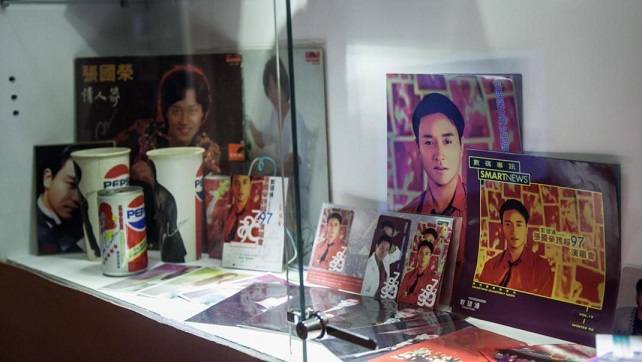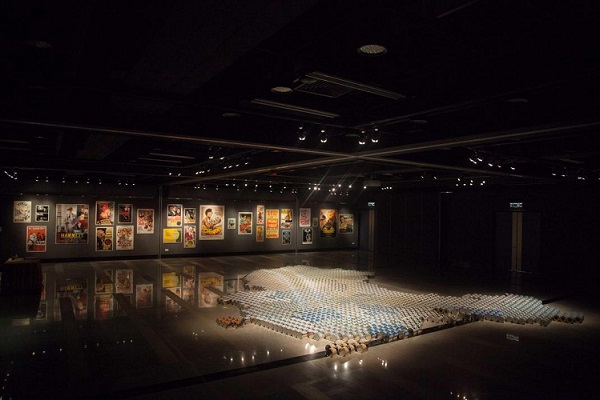Reviews & Articles
A Journal of the Plague Year. Fear, Ghosts, Rebels, SARS, Leslie and the Hong Kong Story
John BATTEN
at 10:07am on 15th October 2013



1.-3. Installation view, A Journal of the Plague Year. Fear, Ghosts, Rebels, SARS, Leslie and the Hong Kong Story Exhibition.
Photos courtesy of Para Site.
(原文以英文發表,評論《疫年日志:恐懼、鬼魂、叛軍、沙士、哥哥和香港的故事》展。)
Racism and colonial superiority underpin this exhibition about Hong Kong’s periodic bouts of sickness and epidemic over the past century. Curated by Para Site’s Cosmin Costinas and independent curator Inti Guerrero, A Journal of the Plague Year juxtaposes, amongst a variety of displays, 19th century newspaper cartoons of the potential “yellow peril” of Asian hordes inundating newer European outposts in the Americas and Australasia alongside a series of displays and videos associating pestilence with race.
Ming Wong’s video of a Charlie Chan-type detective trailing (or is it vice versa?) a woman in a labyrinth of Chinatown streets explores the seeming impenetrability of Chinese culture to outsiders. In James Hong’s compelling and odd Taipei 101 – A Travelogue of Symptoms the narrator increasingly becomes sick on screen as he discusses the sociology of “white men” visiting Taiwan after 9/11 – it is not terrorism, but “earthquakes” and the unseen germs of “SARS that matter.”
Beginning chronologically, this overly ambitious exhibition outlines Hong Kong’s outbreaks of sickness and its responses. Larry Feign’s cartoons of the first interactions between the British and Chinese after Britain’s annexation of Hong Kong Island in 1841 are amusingly mirrored in his own contemporary and real-life cross-cultural marriage to his wife, the character “Lily Wong” of his cartoons.
The 1894 plague outbreak in Hong Kong is depicted in a series of historic photographs of the densely populated Tai Ping Shan area of Sheung Wan being cleaned by sanitary workers. The solution to this “unhealthy” plague environment is Hong Kong’s first forced land resumption. The seizure of private land to be turned into what was believed to be necessary open airy space – Blake Garden - was justified by officials, as is still believed today, of creating a healthier, better environment. However, at that time the forced seizure of private land was controversial and seen as a distasteful solution by members of the then Legislative Council. It is a pity that this was not further explained within the historical ambits of this exhibition, as 120 years later, the current Urban Renewal Authority continues to justify its own land resumptions because they are “improving the city’s slums” – and done despite continuing public protests.
Potent reminders of the 2003 SARS outbreak continue to be seen around Hong Kong: including the ‘self-cleaning alcohol hand sprays’ in office lobbies; and, plastic-sheet covered buttons in elevators. Pak Sheung Chuen’s haunting 3692, 11.05.2003 is a framed found plastic sheet previously covering a building’s access entry code pad - the numbers: 3, 6, 9 and 2 are over-used and their impression embossed onto the plastic.
Ai Weiwei’s installation of milk powder cans in the shape of China is the artistic letdown of the show – without knowledge of the recent milk powder scandal that resulted in thousands of mainland children suffering kidney failure, this work is both obscure and artistically weak. Likewise, a display dedicated to the actor Leslie Cheung is merely a tribute set up by a fan. The actor’s suicide during Hong Kong SAR’s outbreak in 2003 is significant, but this display adds nothing to the cultural importance of his death.
The exhibition unfortunately has few anecdotal memories from 2003. The best exploration of the trauma of SARS is a video interview with journalist Fionnualla McHugh. Her stories are appropriately varied and include postulating if the site of her own Kennedy Town flat, owned by the Tung Wah Group of Hospitals, is the resting place of the 1894 plague victims, buried at the time in Kennedy Town by Tung Wah’s own sanitary workers. However, her interview is in English with no Chinese sub-titles. Unfortunately this is not an oversight: the entire exhibition lacks Chinese captions.
This thoughtful exhibition and its varied range of artwork and historic documentation was ambitious – if time allowed and a few steps back were taken to look at the exhibition in its entirety, the necessary tweaking to make this exhibition compelling may have happened. As it is, the audience is left to either join or unravel the links.
Exhibition:
A Journal of the Plague Year. Fear, Ghosts, Rebels, SARS, Leslie and the Hong Kong Story
@ Para Site Art Space
A version of this review was published in the South China Morning Post on 21 May 2013.
